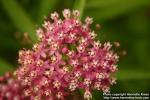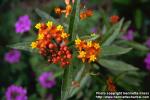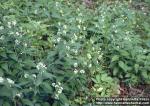Asclepias Incarnata.—Flesh-Colored Asclepias.
 Related plants: Asclepias Cornuti.—Milkweed - Asclepias (U. S. P.)—Asclepias
Related plants: Asclepias Cornuti.—Milkweed - Asclepias (U. S. P.)—Asclepias
The root of the Asclepias incarnata, Linné.
Nat. Ord.—Asclepiadeae.
COMMON NAMES: Flesh-colored asclepias, Swamp milkweed, Swamp silkweed, Rose-colored silkweed, White Indian hemp.
Botanical Source.—Swamp milkweed has a smooth, erect stem, with 2 downy lines above and on the branches and peduncles, branching above, about 3 or 4 feet high. The leaves are opposite, oblong-lanceolate, acute, or pointed, obtuse at the base, on short petioles, and slightly tomentose. The flowers, which are red or reddish-purple and sweet-scented, are disposed in numerous umbels, which are crowded, erect, mostly terminal, and often in opposite pairs. The hoods of the crown are entire; the horns exserted and subulate. The leaves are from 4 to 7 inches long, and from ½ inch to 1 ½ inches wide; the umbels are from 2 to 6, on a peduncle 2 inches long, and consist of from 10 to 20 small flowers. There is a variety of this plant, the Asclepias incarnata var. pulchra, which is more hairy, with broader and shorter petioled leaves.
History.—This herb inhabits damp and wet grounds throughout the United States, and bears red flowers in July and August. On wounding the plant a milky juice exudes. The part used is the root; it varies in thickness from 1 to 6 lines, and is of a light-yellowish or brownish color. It imparts its properties to water.
Description.—The root is about ¾ to ⅘ inch long, oblong, or unsymmetrically globular, hard, knotty, and has attached to it several rootlets 3 to 5 or more inches long. Externally the color is yellow-brown; internally nearly white. The bark is thin, surrounding a wood that is tough and white and has a thick pith. The rootlets are of a pale-brown color and composed about equally of a woody center and whitish bark. The root is nearly without odor and has a sweet, harsh, and finally amarous taste.
Chemical Composition.—The root contains starch, pectin, grape-sugar, albumen, a fixed and a volatile oil, the latter in small amount, two resins of an acrid character (J. Y. Taylor), and an unstable, amorphous, yellow glucoside, asclepiadin, whose physiological effects are similar to those of emetine (Gram, Archiv. f. Exper. Path. und Pharm. 19, page 389).
Action, Medical Uses, and Dosage.—Anthelmintic, for which purpose the powder may be used in doses of 10 to 20 grains, 3 times a day; or the decoction, 2 to 4 fluid ounces. It has been recommended in rheumatic, asthmatic, catarrhal, and syphilitic affections, and as a vermifuge. Said to produce vomiting and purging, but this is doubtful. It is undoubtedly a valuable agent, and worthy of further investigation. According to Frazer (Birmingham Med. Review, 1884) this agent is stomachic and a quick, powerful, and reliable diuretic. It acts upon the heart and circulatory system like foxglove, but without its gastro-intestinal disturbances. It is useful in chronic mucous disease of the stomach and in erysipelatous affections. The dose of the fluid extract, 15 to 60 minims; infusion (℥ss to aqua Oj), ½ to 1 fluid ounce; specific asclepias incarnata, 1 to 10 minims.
Specific Indications and Uses.—Chronic mucous diseases of the stomach; catarrhal discharges; leucorrhoea; entozoic affections.
 Related entry: Asclepias curassavica
Related entry: Asclepias curassavica
Related Species.—Asclepias curassavica, Linné. Habitat: Central America, South America, and West Indies. Bastard ipecacuanha, known also in Central America as ponchishuiz and cancerillo. It is also called Bloodweed and Red head. It is a perennial herb, with red (rarely white) flowers, and its smooth, shining seed-hairs are sometimes called Vegetable silk. This herb yields asclepiadin, a glucoside soluble in alcohol, but scarcely dissolving in ether, yielding to the latter asclepin, a derivative of the former. Among the effects of this drug Guimerais (1881) found it to impress the cardiac muscles and to dilate the larger arteries. Large doses (root 20 to 40 grains) are emetic; smaller doses are cathartic and anthelmintic.
Calotropis gigantea, R. Brown (Asclepias gigantea, Willdenow). Habitat: East Indies and South India; and Calotropis procera, R. Brown (Calotropis Hamiltonii, Wight) North India, West Asia, and Africa. Shrubs yielding Mudar-bark, which contains a bitter principle, an acrid, resinous body, and starch, caoutchouc, and resins. A crystalline body resembling asclepion was found in it by Waddell. The bark has a bitter, acrid, mucilaginous taste.
Mudar-bark (3 or 4 grains) is used as an alterative and tonic in India; in larger doses (20 to 40 grains) it is emetic and diaphoretic, increasing the action of the surface capillaries and absorbents. It is employed as a substitute for ipecac in dysentery; also in leprosy, elephantiasis, rheumatism, dropsy, and syphilis. Dose, 3 to 12 grains, 3 times a day. The dry juice is said to be used in India as an abortivant and to destroy female babies.
 Cynanchum Vincetoxicum, Persoon (Vincetoxicum officinale, Moench; Asclepias Vincetoxicum, Linné). Europe, where it is known as White swallow-wort. The root is employed, and when fresh has a valerian-like odor, which is practically dissipated on drying. It contains fat, essential oil, pectin, and asclepin, a resinous body shown by Gram to be a derivative of asclepiadin, the emetic glucoside. It is thought to be identical with the vincetoxin of Tanret. The bark has an acrid, sweet, and bitterish taste. Emetic, and in large amounts may induce fatal gastric inflammation. Scrofulous and cutaneous disorders have been treated with it.
Cynanchum Vincetoxicum, Persoon (Vincetoxicum officinale, Moench; Asclepias Vincetoxicum, Linné). Europe, where it is known as White swallow-wort. The root is employed, and when fresh has a valerian-like odor, which is practically dissipated on drying. It contains fat, essential oil, pectin, and asclepin, a resinous body shown by Gram to be a derivative of asclepiadin, the emetic glucoside. It is thought to be identical with the vincetoxin of Tanret. The bark has an acrid, sweet, and bitterish taste. Emetic, and in large amounts may induce fatal gastric inflammation. Scrofulous and cutaneous disorders have been treated with it.

